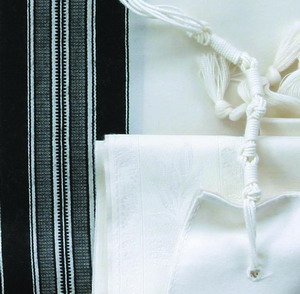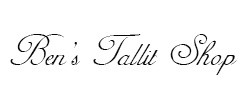All-White Tzitzit
 Many of the tallits we sell come with thin, machine-spun tzitzit standard (Traditional Wool Tallit, Sapir, Bareket, Maalot, Bnei Ohr, Tashbetz) with an option to upgrade to hand-spun tzitzit. Some of our traditional tallitot also come with an option for niputz lishmah, which is a halachic stringency which relatively few of our customers insist on.
Many of the tallits we sell come with thin, machine-spun tzitzit standard (Traditional Wool Tallit, Sapir, Bareket, Maalot, Bnei Ohr, Tashbetz) with an option to upgrade to hand-spun tzitzit. Some of our traditional tallitot also come with an option for niputz lishmah, which is a halachic stringency which relatively few of our customers insist on.
Tzitzit Tying
 We also offer a number of tzitzit tying customs. The most common tzitzit tying custom by far is the standard Ashkenazi tzitzit tying (upper right).
We also offer a number of tzitzit tying customs. The most common tzitzit tying custom by far is the standard Ashkenazi tzitzit tying (upper right).
If you would like Sephardic tzitzit, on most product pages you'll see three options: 10-5-6-5 winding pattern (generally for a tallit katan), the 7-8-11-13 tying pattern (a custom many follow for a tallit katan and the prevalent custom for a tallit gadol) and the Ben Ish Chai variant of the 7-8-11-13 tying pattern.
A third option is Yemenite tzitzit, tied according to the Rambam (left). On most product pages you'll see both a 7 chulyot option and a 13 chulyot option.
A fourth option is Breslov. And finally, we can tie according to the Chabad/Arizal custom.
Thick or Thin?
Halachic Aspects
Generally tzitzit strings are either "machine-spun" or "hand-spun." The latter is sometimes referred to as avodas yad.
The Torah tells us to make tzitzits for ourselves – v’asu lahem tzitzis (Bamidbar 15:38). Based on these words, the Talmudic Sages and later the Shulchan Aruch ruled that tzitzit strings must be made with intent (lishma), i.e. when making the strings one must have intent that they eventually will be used for the mitzvah of tzitzit. You cannot simply buy or make strings and then call them tzitzit.
The question, then, is from what stage of the tzitzit string production process is intention required?
The main stages in the tzitzit production process are known as gozez (shearing), libun (bleaching), niputz (carding), tevia (spinning) and shezira (plying). The basic halacha requirement stated in the Shulchan Aruch (O.C. 11:1) is that you must have tevia lishma (spinning with intention). The Rema notes that according to some opinions you should have niputz lishmah (carding with intention), though he adds that the custom is to be lenient.
The Mishna Berura explains that the mitzvah of making tzitzit (ta’aseh lecha gedilim) starts with tevia, however he does cite some opinions which state that one should try to obtain tzitzit with niputz lishma.
 United States Dollar
United States Dollar
 Shekel
Shekel
 Euro
Euro
 British Pound
British Pound
 Australian Dollar
Australian Dollar
 New Zealand Dollar
New Zealand Dollar
 Canadian Dollar
Canadian Dollar
